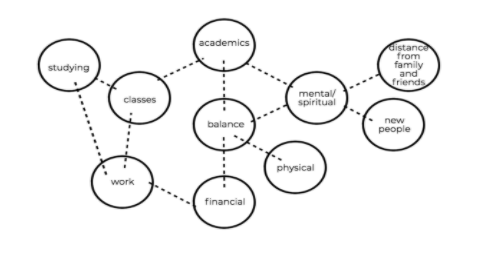3.2: Brainstorming and Prewriting
- Page ID
- 133542
Questions:
- Do you think you need to brainstorm or outline before creating certain projects? Why or why not?
- Why do people (teachers and writers) value brainstorming and prewriting, in your opinion?
Why Prewrite?\(^{61}\)
Prewriting for even 5 to 20 minutes can help you establish what you already know about a paper topic, as well as aid you in discovering where you would like to go with a paper (i.e. what you want to know). It can reveal to you those potential areas of personal interest within the writing task: in a manner of speaking, prewriting enables you to “discover” yourself within the context of your topic. Also, prewriting can act as a tool to ward off or break through what is commonly called “writer’s block” since you’re throwing down EVERYTHING in your head about topic right now!
Brainstorming & Prewriting:
Brainstorming is one of the most effective pre-writing techniques you can use. It’s virtually painless and can be pretty fun, if you let it be! Let your mind wander and think about things that you would like to explore more. Try to create a mental web of things you can connect to one another. Let the lightning of ideas strike you as they may. If you’d like a bit more structure in your prewriting, try one of these methods: Listing, Freewriting, Outling, and Clustering. Here are examples of those methods:
Listing:
IF the assignment is an essay about anything you want to learn more about, perhaps you might wonder how other humans in college find BALANCE.
- Balancing classes and work
- Studying better and more efficiently
- Distant friendships vs finding new ones on campus
- How do I find time to take care of myself?
Freewriting:
IF the assignment is to identify one’s teaching philosophy:
Thursday January 23, 2003\(^{62}\)
|
In one of my own classes, I have to come up with my Teaching Philosophy.. theories as to how and why I teach, etc.. also theories/analyzations behind the assignments I assign. Hmm.. here's a freewrite about those things: Posted 1/23/2003 at 12:38 PM |
Outline:
IF the assignment is an argument about WHY balance is necessary, here’s a possible outline that could be followed:
- Intro: Why We Need Balance
- Mental/Spiritual
- Academic
- Financial
- Obstacles to Finding Balance
- People
- Stress and Illness
- Who Has Found Balance?
- Examples
- Tips on Finding Balance
- Be Organized
- Find Routines that work for you
Clustering:

\(^{61}\)“Basic Writing/Print version.” Wikibooks, The Free Textbook Project. 9 Sep 2008, 16:02 UTC. 11 May 2016, 18:08 <https://en.wikibooks.org/w/index.php...&oldid=1273791>. Licensed CC-BY-SA.
\(^{62}\)Blog post by Sybil Priebe is licensed CC-BY.


